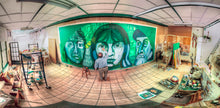
This outstanding painting measures 26 x 18" (65 x 45cm.). It is mixed media on heavy paper. This work was done in 1984.
Ceniceros is a very well established Mexican Master, having participated in over 200 solo and group shows around the world. He was the foremost apprentice of the Mexican Master David Siqueiros, and was his assistant, while he was executing many of his great murals. This is a truly outstanding example of his work, done in the early 1990's. He began exhibiting in 1956, at the age of 16. This outstanding artist not only has a museum in Durango, Mexico devoted entirely to his work.
Ceniceros did his first mural while he was still in Monterrey, working on the La Ciudadela municipal library in the city. However, much of his early experience with the art form was as an assistant to established artists. Federico Cantú hired him as an assistant with the 600m2 mural work at the Sierra de los Altares, a relief work made with natural stone. This led to work two years later with Luis Covarrubias to paint ethnographic murals at the Museo Nacional de Antropología. During this project he was able to meet Rufino Tamayo, José Chávez Morado, Jorge González Camarena and Raúl Anguiano . In 1965, he was then hired by David Alfaro Siqueiros, working on murals such as The March of Humanity on Earth and Towards the Cosmos at the Polyforum Cultural Siqueiros . He then also worked with the master on murals at the Museo Nacional de Historia at Chapultepec Castle, the former customs building in Santo Domingo and the site of the Asociación Nacional de Actores. The work with Siqueiros was a major influence on his development, introducing him to new techniques, materials, tools, compositions and perspectives. The idea of inventing one’s own tools he got from Siqueira. Ceniceros would become one of Siqueros most notable apprentices.
He has created over fifteen large scale murals in public places. the Centro de Arte Moderno, Guadalajara (1980), the Mexican Mission to the United Nations (1984), Metro Tacubaya (1986), The Ancient Mexicans, a mural for the Mexican Pavilion at the International Exhibition in Vancouver, Canada. (1986), Metro Copilco (1988), Maderos Theater UANL (1990), the Palacio de Justicia in Monterrey (1991), Banco Nacional de Comercio Exterior, Monterrey (1994), the Chemistry department at UANL (1998), Santa Engracia Hospital in Monterrey (1999) and the Theatre of the Sindicato Nacional de Trabajadores Telefónicos in Mexico City (2001), Metáforos Lúdicas in the city of Durango (2008) and La Historia del Pueblo Mexicano a través de su Vida Constitucional at the Palacio Legislativo to commemorate the Bicentennial of Independence and Centennial of the Mexican Revolution (2012) . He also painted a mural for the cultural center of his hometown of El Salto.
Ceniceros had his first exhibition of artwork in 1956 at the Galería de Arte, A.C. in 1956. His work began to be shown regularly in 1969 with an exhibition that established him at the Palacio de Bellas Artes, with shows eventually in various parts of Mexico as well as abroad in countries such as Cuba, Ecuador and Eastern Europe with over two hundred exhibitions as of 2003. In 1970 he exhibited at the Museo de Arte Moderno, winning the Salón Annual de la Plástica Mexicana Prize. The museum bought the piece. Other important ones include the Martin Gallery in Minneapolis (1972), the Museo Nacional de Bellas Artes de La Habana (1972), the Museo Nacional de Bellas Artes in Santiago de Chile (1973), the Museo Guayasamín in Quito (1976), the Atelier Guayasamín in Caracas (1976), the Pulchri Studio in The Hague (1980), International Development Bank Gallery in Washington (1984), Iturralde Gallery in La Jolla, CA (1989), Museo Universitario de Ciencias y Artes (1992) and the Nagoya City Art Museum, Japan (1994) .
His recognitions include two awards, the National Painting Prize from the Secretaría de Educación Pública in 1969 and the keys to the city of Durango as a distinguished visitor in 2008. In 1998, the state of Durango accepted a donation of paintings from the artist and sponsored the establishment of the Museo de Arte Moderno Guillermo Ceniceros in the capital. It occupies the main house of the former Hacienda Ferrería de Flores, which dates to the 19th century. Five halls are dedicated to the permanent collection with the other four dedicated to temporary exhibits. In 2009, for his seventieth birthday, the states of Durango and Nuevo León sponsored the production of his biography, called Guillermo Ceniceros: setenta años, published by La Cabra Ediciones. He is also a member of the Salón de la Plástica Mexicana.











